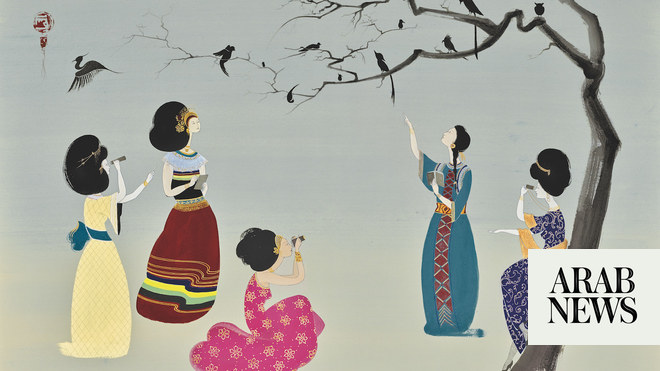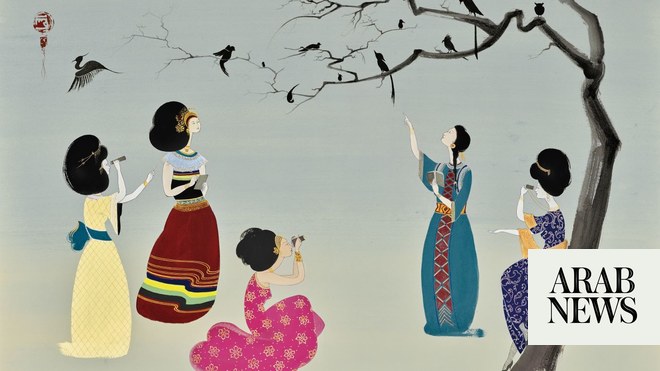
Highlights from the auction house’s Modern and Contemporary Middle Easter Art sale
DUBAI: After a three-year interval because of the COVID-19 pandemic, Christie’s Modern and Contemporary Middle Eastern Art sale is back in action in Dubai. Bidding takes place online until May 16. The sale presents a diverse mix of more than 60 works by 20th-century modern masters and rising contemporary artists. The works are also on display at the Dubai International Financial Centre from May 8.
For the latest updates, follow us on Instagram @arabnews.lifestyle
While there has always been great interest in the auction from Middle Eastern collectors in the region and abroad, there has also been a notable upturn in bids from international clients. “It’s a very encouraging moment for the Middle East market, as much as it is for African and Southeast Asian markets. It’s been exciting,” specialist Suzy Sikorski tells Arab News. Here are some highlights of works by Arab artists in the upcoming sale.
‘Wild’
Mohamed Melehi
One of the sale’s top two highlights is this 1960s painting made by the postcolonial Moroccan modernist, famed for his ‘wave’ paintings like this one. In the Sixties, Melehi was a key leader of the Casablanca Art School, one of the main initiatives of which was to take art to the streets through urban murals. “You see a lot of his wave works do very well at auction,” Sikorski says. “This is a unique collector’s piece, because it’s difficult to source.”
‘Icosahedron within a Dodecahedron’
Dana Awartani
Made of wood, copper and glass, this tectonic sculpture was created in 2016 by the Palestinian-Saudi artist as part of her “Platonic Solid Duals” series. In a single piece, it combines the five shapes of platonic solids that have historically exemplified visual flawlessness. “The platonic solids are the most frequently studied shapes in history,” according to her artist statement. “For thousands of years, geometers have studied their mathematical properties and have been fascinated by their inherent beauty and symmetry. What makes them particularly important is that they are considered the only five ‘perfect’ shapes in three-dimensional space that derive from a sphere.”
‘Khat wa Rasm’
Etel Adnan
A rare example of the acclaimed Lebanese-American writer and artist’s foldable, accordion-like ‘leporello’ works. Created in 1986 and signed by the artist, this leporello book — of which only a portion is shown in this image — is five meters wide and contains 28 colorful pages marked by bright watercolors. The Arabic ink writings that dot its pages are a tribute to the Iraqi poet Shawqi Abdul Amir, according to Sikorski. “It’s a beautiful blend between her writing and landscape compositions, which was always something so sought after internationally,” she says.
‘Kurdish Women’
Hayv Kahraman
In this work, the Los Angeles-based Iraqi-Kurdish artist depicts five Kurdish women contemplating birds on a leafless black tree. With its Japanese sumi ink, the work contains elements of ancient Asian painting — highlighting Kahraman’s interest in art history. “It’s a beautiful work, especially with the different blocks of color, geometric shapes, and the traditional Kurdish fashion,” Sikorski says.
‘Hajj’
Reem Al-Faisal
The Saudi photographer — known for her black-and-white imagery — was reportedly the first woman to take shots of the Hajj in Makkah. A selection of Al-Faisal’s work was recently featured at the Islamic Arts Biennale that opened in Jeddah in January. “The black-and-white encourages the viewer to disassociate with the physical world and look beyond it, into the spiritual,” she previously told Arab News. This image was taken at the Hajj in 2011 and shows the crowded area around the Kaaba. “The local community has quite a strong appetite for photography,” Sikorski notes.
‘Acrylic on Scratched Paper’
Mohammed Kazem
Kazem is one of the UAE’s most important artists. This 2021 work is part of his ongoing ‘scratch’ paintings, which he began in the late Eighties. With a pair of scissors, he scratches the paper’s surface, generating “a visual representation of sound.” This practice, he has said, “has become fundamental in shaping how I experience the world by capturing light, sound and its infinite movement.” A statement from Christie’s reads: “These works are meditative in nature, the artist’s method being quite painstakingly slow. We see the introduction of vivid color, in one solid tone, creating a color field in Kazem’s world.”
‘Kitabat A"la Jidar Raqam’
Shaker Hassan Al-Said
Al-Said is considered one of the pioneers of Iraqi modernism. He co-founded the Baghdad Group for Modern Art with Jewad Selim in 1951. In the 1970s, he founded and explored his philosophy of ‘one dimension,’ meaning eternity — in which the artwork has no beginning or end. This abstract painting from 1978 was previously showcased at The Sultan Gallery in Kuwait. “It’s a gorgeous one,” remarks Sikorski. “It has more of a color scheme than others.”












